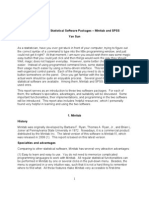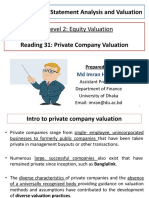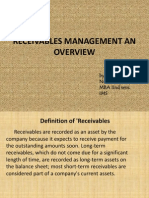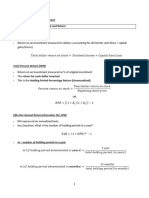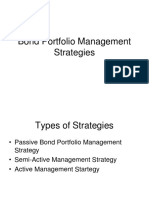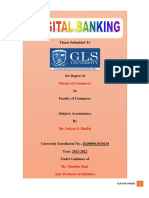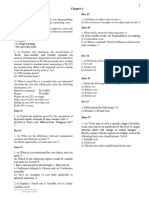Bankruptcy Prediction Models-Artikel
Bankruptcy Prediction Models-Artikel
Uploaded by
Ljiljana SorakCopyright:
Available Formats
Bankruptcy Prediction Models-Artikel
Bankruptcy Prediction Models-Artikel
Uploaded by
Ljiljana SorakCopyright
Available Formats
Share this document
Did you find this document useful?
Is this content inappropriate?
Copyright:
Available Formats
Bankruptcy Prediction Models-Artikel
Bankruptcy Prediction Models-Artikel
Uploaded by
Ljiljana SorakCopyright:
Available Formats
Bankruptcy prediction models Hughes, Stewart. Credit Control. Hutton: 1993. Vol. 14, Iss. 11; pg.
16, 7 pgs Abstract (Summary) Bankruptcy prediction models are reviewed. The relative merits of univariate financial ratio analysis, multi-discriminant analysis, and managerial performance models are examined. It is found that each of these models needs to be supplemented by a sobering review of economic fundamentals. Financial analysts and experienced credit managers are often able to predict the likelihood of a firm experiencing financial difficulties, possibly leading to bankruptcy, by monitoring closely its performance over a long period. Techniques available for predicting corporate bankruptcy are discussed. In general, if one is in the business of analyzing company performance, it is clear that both financial and non-financial indicators should be taken into account. Moreover, it is inappropriate simply to use historic accounting data and project it into the future. It is necessary to incorporate into the analysis predictions about the level of economic activity and, in particular, the impact of prolonged high interest rates. Full Text (1789 words) Copyright House of Words, Ltd. 1993 With the British economy emerging from a deep recession, it is an appropriate moment to review the use of bankruptcy prediction models. Here we examine the relative merits of univariate financial ratio analysis, multi-discriminant analysis and managerial performance models. We find that each of these models needs to be supplemented by a sobering review of economic fundamentals. Financial analysts and experienced Credit Managers are often able to predict the likelihood of a firm experiencing financial difficulties, possibly leading to bankruptcy, by monitoring closely its performance over a long period. Techniques available for predicting corporate bankruptcy fall into the three major types discussed below. 1. UNIVARIATE FINANCIAL RATIO ANALYSIS The analysis of a company's financial ratios both on a cross-sectional basis (comparisons with firms in similar industries) and on a time-series basis (comparisons within the same firm over time) have been the traditional method used to predict deterioration in a company's financial health. The major ratios used in this kind of analysis have included profitability ratios, liquidity ratios, gearing ratios, activity ratios and investment ratios. Deterioration in these either over time within the same company or in respect to intercompany comparisons frequently set alarm bells ringing in the boardroom and among the financial press. The problems of using such ratios for performance prediction are well documented, particularly those involving inter-company comparisons in industries where fins are highly diversified on both a product and geographical basis. However, besides these problems, from the point of view of bankruptcy prediction, there arises the basic problem that financial ratio analysis is essentially a univariate technique. In other words, the
problem with financial ratio analysis is that each ratio is examined separately, in isolation from the other ratios. Consequently, the analysis has the problem of not only deciding whether a particular ratio is good or bad (e.g., a low gearing ratio could indicate either that there is a strong equity base or that the firm is reluctant to take on risk) but also that different ratios may be moving in opposite directions, thereby indicating different predictions. In effect, the major problem of using univariate financial ratio analysis for bankruptcy prediction purposes is that the combined effect of several ratios are based solely on the subjective judgement of the financial analyst. 2. MULTIPLE DISCRIMINANT ANALYSIS (MDA) This was developed largely in response to the shortcomings of univariate financial ratio analysis. Multi-discriminant analysis (MDA) starts from the premise that a company's accounts are multivariate documents in that they measure several aspects of a company's performance simultaneously. Therefore, to evaluate a company simply on the basis of one aspect of its performance such as its profitability would be dangerously to ignore other aspects of its performance such as its liquidity and its financial risk. The first attempt to use MDA for bankruptcy prediction purposes was the model developed by Edward Altman in the US in 1968. Since then the technique has been developed by Taffler, Tisshaw and others in the United Kingdom. Essentially, all variations of the technique involve the following three steps: (a) establish two mutually exclusive groups, namely those firms which have gone bankrupt and those which are still continuing to trade successfully; (b) collect financial ratios for both of these two groups; (c) identify the financial ratios which best discriminate between the two groups. Altman, in his original work, found that there were five key ratios which best discriminated between the bankrupt and non-bankrupt firms. He used these ratios to calculate a Z score as follows: Z=.012X sub 1 +.014X sub 2 +.033X sub 3 +.006X sub 4 + .999X sub 5 where X sub 1 =working capital/total assets (%) X sub 2 =retained earnings/total assets (%) X sub 3 =earnings before interest and tax/total assets (%) X sub 4 =market value of equity/book value of debt(%) X sub 5 =sales/total assets
Altman applied his model to 66 firms, half of which had gone bankrupt. He found that the average of the five ratios for his equal groups of bankrupt and non-bankrupt firms were as follows: (Averages omitted) Substituting these values into the equation, the Z score for bankrupt and non bankrupt firms becomes: (Z score omitted) Altman found that the key Z score was 2.675. Firms with Z scores above this were declared as non-bankrupt while those with Z scores below this were classified as bankrupt. The most important discriminator between bankrupt and non-bankrupt firms he found to be the profitability ratio X sub 3 , followed by X sub 5 , X sub 4 , X sub 2 and X sub 1 . He further claimed that using a Z score of 2.675 as the classification boundary (i.e., as between bankrupt and non-bankrupt firms) that his model was 95 percent accurate in predicting one year prior to bankruptcy, and 72 percent accurate when applied to company data two to five years prior to bankruptcy. MDA analysis has clear advantages over simple financial ratio analysis in that it is based on objective statistical data rather than upon the subjective interpretations of the financial analyst. However, any model can only be as good as the data on which it is based. Consequently, even assuming the predictive accuracy of MDA models are as good as their exponents argue, there are still the problems of changes in accounting practices, creative accounting and the fact that companies in financial difficulties frequently tend to delay the publication of their accounts. Moreover, MDA models are based on historical data and may fail to identify major changes in the company's competitive environment or management structure. Thus, predictions based on MDA may be useful starting points but they are unlikely to tell the whole story. 3. MANAGERIAL PERFORMANCE MODELS Managerial models are much more subjective than MDA models and are based upon the analyst's judgment in relation to the overall managerial, financial and trading position of the firm. The best known of these models is the Argenti 'A' score model in which he attempts to quantify performance by attaching scores to various characteristics of performance. Scores are awarded under three major headings in the Argenti framework, namely defects, mistakes and symptoms. A maximum of 100 marks may be awarded overall, comprising 43 for the defects section, 45 for mistakes and 12 for symptoms. The higher the score awarded the more likely it is the company is badly run and is heading for failure. In the Argenti model, defects are deemed to be of three major types. The first is the managerial structure where Argenti argues that failure is most likely to be associated with autocratic chief executives, particularly where the chief executive is also the chairman. If
is accompanied by an unbalanced, passive board with a weak finance director and a lack of professional managers below board level, the probability of failure is likely to increase. The second defect is to be found in weak accounting systems, particularly where there is no proper budgetary control system, an inadequate cash flow planning system and poor or nonexistent product costing. The final defect is to be found in management's lack of response to change, particularly in relation to changing products, processes, markets and work practices. Of the 43 marks awarded for the defects section, 19 are awarded for management structure, 9 for accounting controls, and 15 for responsiveness to change. Because of these defects in the managerial and accounting set-up, Argenti argues that these can lead to three major mistakes being made. The first of these is overtrading, whereby the company's turnover rises faster than its cash availability, thereby leading to cash flow problems. The second is where the company's financial structure becomes characterised by high gearing, so that the interest on the company's loans become a major burden on its profits. The third major mistake is the big project, where the company takes on a project of such a scale in relation to the company's size, that if the project goes wrong it can cause the entire company to collapse. Each of these mistakes are regarded as of equal magnitude in the Argenti model and are each awarded 15 marks in his scoring system. The third section of Argenti's model concerns the symptoms which begin to appear as the company lurches towards failure. (Argenti's model omitted). These include both financial and non-financial symptoms. Financial symptoms take the form of deteriorating financial ratios or Z scores and the use of creative accounting which together are awarded eight marks. Finally, nonfinancial indicators such as declining morale, market share, adverse rumours and resignations together comprise the final four marks. The scoring system as devised by Argenti is extremely rigid. The allocation of marks is an all or nothing procedure, with either the full mark being awarded or a zero mark, the model not allowing any intermediate scores. The overall danger mark above which companies may be in danger of failing is 25, although an individual score of 10 or more for the defects and 15 for the mistakes would also put the company at serious risk. There is plenty of scope for developing models along the Argenti line of thinking. The problem with these models is that they tend to be based upon subjective judgements, not only in terms of the variables to be included in the model but also in terms of the scoring system to adopt. It is an arbitrary judgment as to what is the appropriate level of gearing or whether existing management is autocratic. An interesting feature of the Argenti model is that it relegates deteriorating financial ratios to a relatively minor role. However, casual empiricism tends to lend support to the major role played by the three big mistakes of overtaking, overgearing and the big project, in causing company collapse. What, then, can we conclude about bankruptcy prediction models? If one is in the business of analysing company performance, it is clear that both financial and nonfinancial indicators should be taken into account. Moreover, it is inappropriate simply to
use historic accounting data and project it into the future. It is necessary to incorporate into the analysis, predictions about the level of economic activity and in particular, the impact of prolonged high interest rates. The inability to predict some of the major corporate collapses of the past two years suggests that many analyst are still not taking account of the impact of economic fundamentals upon future performance. REFERENCES A.I. Altman: 'Discriminant analysis and the prediction of corporate bankruptcy", Journal of Finance, September 68, Vol 23. J. Argenti: 'Discerning the signs of company failure", The Director, October 83, Vol 37. This article first appeared in the June 1993 issue of Student Digest and is reproduced with the kind permission of the Institute of Company Accountants. Stewart Hughes, MA, FSCA, Senior Lecturer, Coventry University
You might also like
- Trading Hub 2.o-2Document10 pagesTrading Hub 2.o-2Reynor Alvin Caceres Garnica92% (25)
- Materials For How To Handle BIR Audit Procedures of BIR Audit - 2021 Sept 21Document83 pagesMaterials For How To Handle BIR Audit Procedures of BIR Audit - 2021 Sept 21cool_peach100% (2)
- Foundational Theories and Techniques for Risk Management, A Guide for Professional Risk Managers in Financial Services - Part II - Financial InstrumentsFrom EverandFoundational Theories and Techniques for Risk Management, A Guide for Professional Risk Managers in Financial Services - Part II - Financial InstrumentsNo ratings yet
- Cfa Level 1 EthicsDocument6 pagesCfa Level 1 EthicsSurendra PandeyNo ratings yet
- 479 Questions + Answers: Cfa ExamDocument189 pages479 Questions + Answers: Cfa ExamAbdullah MantawyNo ratings yet
- 5.1foreign Exchange Rate Determination and ForecastingDocument34 pages5.1foreign Exchange Rate Determination and ForecastingSanaFatimaNo ratings yet
- 7.4 Options - Pricing Model - Black ScholesDocument36 pages7.4 Options - Pricing Model - Black ScholesSiva SankarNo ratings yet
- ACF 602/622 Coursework: Group 53Document13 pagesACF 602/622 Coursework: Group 53Shihab HasanNo ratings yet
- Ch-12 Recommending Model Portfolios and Financial PlansDocument8 pagesCh-12 Recommending Model Portfolios and Financial PlansrishabhNo ratings yet
- Minitab Vs SPSSDocument11 pagesMinitab Vs SPSSsantosh234No ratings yet
- Portfolio Management FerdinandDocument13 pagesPortfolio Management FerdinandFerdinand Troedu P GultomNo ratings yet
- MACR-03 - Drivers For M&ADocument6 pagesMACR-03 - Drivers For M&AVivek KuchhalNo ratings yet
- Financial Statements AnalysisDocument8 pagesFinancial Statements AnalysisFranz CampuedNo ratings yet
- Literature ReviewDocument7 pagesLiterature ReviewadjoeadNo ratings yet
- Class 1 Investments BKM Chapter9Document19 pagesClass 1 Investments BKM Chapter9Daniel PortellaNo ratings yet
- Nism Research Analysts QuestionsDocument129 pagesNism Research Analysts QuestionsAyush NautiyalNo ratings yet
- Investment BKM 5th EditonDocument21 pagesInvestment BKM 5th EditonKonstantin BezuhanovNo ratings yet
- Introduction To Risk, Return, and The Historical Record: InvestmentsDocument44 pagesIntroduction To Risk, Return, and The Historical Record: InvestmentsSaurav SinghNo ratings yet
- Wheelan 14e ch01Document40 pagesWheelan 14e ch01Anu PomNo ratings yet
- Reading 31 Slides - Private Company ValuationDocument57 pagesReading 31 Slides - Private Company ValuationtamannaakterNo ratings yet
- Hedge Funds: Approaches To Diversification: Firevision, LLC & Professor Robert McdonaldDocument50 pagesHedge Funds: Approaches To Diversification: Firevision, LLC & Professor Robert McdonaldDenis CruzeNo ratings yet
- Portfolio TheoryDocument3 pagesPortfolio TheoryZain MughalNo ratings yet
- Equity ValuationDocument10 pagesEquity ValuationJasmine NandaNo ratings yet
- By Mahendra Singh SikarwarDocument21 pagesBy Mahendra Singh Sikarwarmss_singh_sikarwarNo ratings yet
- Receivabbles Management An OverviewDocument10 pagesReceivabbles Management An OverviewHonika PareekNo ratings yet
- Total Dollar Return: Investment Portfolio Management WEEK 1: A Brief History of Risk and ReturnDocument43 pagesTotal Dollar Return: Investment Portfolio Management WEEK 1: A Brief History of Risk and ReturnVenessa Yong100% (1)
- FRM Book 4Document5 pagesFRM Book 4Nguyễn Anh DươngNo ratings yet
- BKM ch06 PDFDocument41 pagesBKM ch06 PDFEnayet HossainNo ratings yet
- EMH EmpiricalDocument57 pagesEMH EmpiricalnasrullohNo ratings yet
- Interest Rate FutureDocument19 pagesInterest Rate FutureDivyesh GandhiNo ratings yet
- IAE Chap 24 Portfolio Performance EvaluationDocument34 pagesIAE Chap 24 Portfolio Performance EvaluationAlfaRahmatMaulanaNo ratings yet
- KPMG GRP 1Document47 pagesKPMG GRP 1Onkar ShindeNo ratings yet
- Writing A Journal Article: Guidance For Novice Authors: Continuing Professional DevelopmentDocument8 pagesWriting A Journal Article: Guidance For Novice Authors: Continuing Professional DevelopmentRajkumar35No ratings yet
- Hofers ModelDocument11 pagesHofers ModelnarangjyotiNo ratings yet
- Columbia CaseDocument75 pagesColumbia CaseSébastien RodriguesNo ratings yet
- Risk and Return For Individual SecuritiesDocument6 pagesRisk and Return For Individual SecuritiesDavid RiveraNo ratings yet
- 2017年CFA一级另类投资考点汇总中文版高清Document3 pages2017年CFA一级另类投资考点汇总中文版高清Ives LeeNo ratings yet
- FIN630 Short Notes For Lecture 23-45 by Humaira PDFDocument45 pagesFIN630 Short Notes For Lecture 23-45 by Humaira PDFsohaib shahidNo ratings yet
- A 109 SMDocument39 pagesA 109 SMRam Krishna KrishNo ratings yet
- Top 33 Investment Banking Interview Questions AnswersDocument7 pagesTop 33 Investment Banking Interview Questions AnswersRidwan KabirNo ratings yet
- The Term Structure of Interest Rates: Denitsa StefanovaDocument41 pagesThe Term Structure of Interest Rates: Denitsa StefanovathofkampNo ratings yet
- Dividend Discount ModelDocument9 pagesDividend Discount ModelVatsal SinghNo ratings yet
- Equity MarketsDocument5 pagesEquity MarketsJitendra KhareNo ratings yet
- Arbitage TheoryDocument9 pagesArbitage Theorymahesh19689No ratings yet
- Lesson 4Document114 pagesLesson 4Quyen Thanh NguyenNo ratings yet
- 7Document77 pages7Madina SuleimenovaNo ratings yet
- Q3 Steel 10.2Document3 pagesQ3 Steel 10.2viv3kswamyNo ratings yet
- Credit RatingDocument13 pagesCredit RatingMohammed JashidNo ratings yet
- EC3333 NotesDocument25 pagesEC3333 Notesxqhuang99No ratings yet
- Portfolio AnalysisDocument18 pagesPortfolio Analysissubscription accountNo ratings yet
- Risk and Return 2009Document10 pagesRisk and Return 2009Rajkumar35No ratings yet
- Bond Portfolio Management StrategiesDocument32 pagesBond Portfolio Management StrategiesSwati VermaNo ratings yet
- Risk and Capital Budgeting: Foundations of Financial ManagementDocument39 pagesRisk and Capital Budgeting: Foundations of Financial ManagementBlack UnicornNo ratings yet
- SFM MaterialDocument106 pagesSFM MaterialAlok67% (3)
- Security Market LineDocument5 pagesSecurity Market LineHAFIAZ MUHAMMAD IMTIAZ100% (1)
- Fixed - Income CfaDocument21 pagesFixed - Income CfaSophy ThweNo ratings yet
- Into To Treasury & Risk Management - FinalDocument21 pagesInto To Treasury & Risk Management - FinalGaurav AgrawalNo ratings yet
- A Better Three-Factor Model That Explains More AnomaliesDocument68 pagesA Better Three-Factor Model That Explains More AnomalieschrisNo ratings yet
- SFM PDFDocument328 pagesSFM PDFZainNo ratings yet
- LM01 Study Notes - IFT WorldDocument6 pagesLM01 Study Notes - IFT Worldjustlofi23No ratings yet
- Business Failure: Prediction and PreventionDocument4 pagesBusiness Failure: Prediction and Preventionbibs213No ratings yet
- NACH FormDocument2 pagesNACH FormShreyas WaghmareNo ratings yet
- Comparative Analysis Financial Performance of INDUSIND BANK With Other Four BanksDocument85 pagesComparative Analysis Financial Performance of INDUSIND BANK With Other Four Bankskawalpreetyahoo0% (1)
- Project Work Report On Channel Management - in Mutual Fund SalesDocument104 pagesProject Work Report On Channel Management - in Mutual Fund Salesramesh100% (2)
- Write Your Business Plan.: WWW - Teneric.co - UkDocument5 pagesWrite Your Business Plan.: WWW - Teneric.co - Uk6062No ratings yet
- Ifrs 15Document89 pagesIfrs 15milithebillyNo ratings yet
- Takeover Defenses in The United KingdomDocument14 pagesTakeover Defenses in The United KingdomDidier LamarcheNo ratings yet
- G.R. No. 137172 UCPB vs. MasaganaDocument11 pagesG.R. No. 137172 UCPB vs. Masaganachristopher d. balubayanNo ratings yet
- Business Finance Decisions: Certified Finance and Accounting Professional Stage ExaminationDocument5 pagesBusiness Finance Decisions: Certified Finance and Accounting Professional Stage ExaminationSyed Muhammad JawwadNo ratings yet
- Which Index Options Should You Sell?: Roni Israelov Harsha TummalaDocument35 pagesWhich Index Options Should You Sell?: Roni Israelov Harsha TummalaZachary PorgessNo ratings yet
- AVPN July Webinar PresentationDocument22 pagesAVPN July Webinar PresentationpattichuNo ratings yet
- General Socio-Economic & Banking AwarenessDocument4 pagesGeneral Socio-Economic & Banking AwarenessKapil MalikNo ratings yet
- Chandragiri 071-072 ProvsionalDocument9 pagesChandragiri 071-072 ProvsionalBright Tone Music InstituteNo ratings yet
- Coaching Discussion 04 (Economics Problems) : R S R S R S R SDocument5 pagesCoaching Discussion 04 (Economics Problems) : R S R S R S R SLao GeneNo ratings yet
- LK INDOFARMA 2018 - CompressedDocument89 pagesLK INDOFARMA 2018 - CompressedDika DaniswaraNo ratings yet
- Module 13 - BusCom - Forex. - StudentsDocument13 pagesModule 13 - BusCom - Forex. - StudentsLuisito CorreaNo ratings yet
- United States v. Shimer, 367 U.S. 374 (1961)Document11 pagesUnited States v. Shimer, 367 U.S. 374 (1961)Scribd Government DocsNo ratings yet
- DILG Memo Circular 2011-08Document15 pagesDILG Memo Circular 2011-08Erika Mae GumabolNo ratings yet
- Wa0000.Document9 pagesWa0000.manikdarshanNo ratings yet
- Break Even Analysis Final Term Lesson Activity 1Document53 pagesBreak Even Analysis Final Term Lesson Activity 1温埃德No ratings yet
- Literature Review On Npa in SbiDocument4 pagesLiterature Review On Npa in Sbirpmvtcrif100% (1)
- Royalty AccountDocument2 pagesRoyalty AccountSuman MishraNo ratings yet
- 6.1 and 6.2 - Balance of Payments Accounts & Exchange RatesDocument5 pages6.1 and 6.2 - Balance of Payments Accounts & Exchange RatesReed-Animated ProductionsNo ratings yet
- Arf 1 Form-TnpgtaDocument12 pagesArf 1 Form-TnpgtaGnanam SekaranNo ratings yet
- Economy: 5. Able To Identify The Language Function of Direct and Indirect SpeechDocument7 pagesEconomy: 5. Able To Identify The Language Function of Direct and Indirect Speechregeg astikaNo ratings yet
- Digital Banking Research Paper by Sufyan ShaikhDocument67 pagesDigital Banking Research Paper by Sufyan ShaikhSufyan ShaikhNo ratings yet
- Amc CDPDocument180 pagesAmc CDPStela PatelNo ratings yet
- MI Chapter-Wise Question CompiledDocument35 pagesMI Chapter-Wise Question CompiledS.M. Hasib Ul IslamNo ratings yet
- Loan Functions of BanksDocument6 pagesLoan Functions of BanksMark AmistosoNo ratings yet










